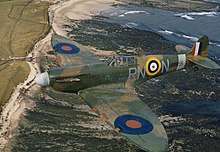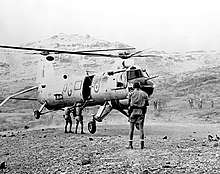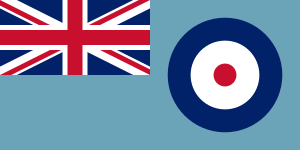No. 72 Squadron RAF
Number 72 Squadron of the Royal Air Force is a training squadron that is currently based at RAF Valley using the Beechcraft Texan T.1 to deliver Basic Fast Jet Training (BJFT).
| No. 72 Squadron RAF | |
|---|---|
 | |
| Active | 28 June 1917 – 1 April 1918 (RFC) 1 April 1918 – 22 September 1919 (RAF) 22 February 1937 – 30 December 1946 1 February 1947 – 30 June 1961 15 November 1961 – 1 April 2002 12 July 2002 – 31 October 2019 28 November 2019 – present |
| Country | |
| Branch | |
| Type | Flying training squadron |
| Role | Advanced flying training |
| Part of | No. 22 Group No. 4 Flying Training School |
| Home station | RAF Valley |
| Nickname(s) | 'Basutoland'[1] |
| Motto(s) | Swift[2] |
| Aircraft | Beechcraft Texan T.1 |
| Battle honours |
|
| Insignia | |
| Squadron badge heraldry | A swift volant, intended to symbolise speed.[3] |
| Post 1950 squadron insignia | |
| Squadron codes | RN (Oct 1938 – Apr 1939)[4] SD (Apr 1939 – Sep 1939)[4][5] RN (Sep 1939 – Dec 1946)[6][7] FG (Jan 1947 – Apr 1951)[8][9] AA–AZ (Wessex)[10] |
It was previously based at RAF Linton-on-Ouse using the Short Tucano T.1, a modified version of the Brazilian Embraer EMB-312 Tucano training aircraft. No. 72 Squadron started its service life supporting the army during World War I on operations in Middle East and afterwards was quickly disbanded. In its second incarnation the squadron was a real fighter unit, transitioning from Gloster Gladiator biplanes[11] to Gloster Javelin all-weather jets, in between flying the Supermarine Spitfire during the Battle of Britain. The jets went in 1961 and from then until 1 April 2002 the squadron flew helicopters in the transport role.
The squadron nickname, "Basutoland", is derived from the fact that during both world wars, the Basutoland Protectorate, now Lesotho, donated aircraft to RAF, which were assigned to No. 72 Squadron.[12]
History
First World War
No. 72 Squadron was formed on 28 June 1917 at Upavon as a squadron of the Royal Flying Corps.[3][13] On Christmas Day, the squadron left for the Middle East and regrouped at Basra on 2 March. Here, they split in three flights, each assisting the Army in their various missions, and were disbanded in Baghdad on 22 September 1919.[3]
Second World War

No. 72 Squadron was reformed at RAF Tangmere on 22 February 1937 from 'B' flight of No. 1 Squadron.[3] In 1939, the squadron was outfitted with Supermarine Spitfires which replaced the Gloster Gladiators that came with the flight from No. 1 Squadron. These were used in Air defence and convoy protection duties following the start of World War II. Then, in 1940, the squadron moved to assist in the evacuation of Dunkirk.[14]
During the Battle of Britain, No. 72 Squadron spent the early days at RAF Acklington as part of No. 13 Group, before moving south during September to aid the main defence force. The squadron was then moved to North Africa to support the Tunisian campaign before being supplied with the updated Spitfire Mk.IX in 1942. They then assisted the British 8th Army as they advanced through Italy and France up until the German surrender. At this point they were moved to Austria. It was here they were disbanded on 30 December 1946 at Zeltweg.[3]
Post-War jets
.jpg)
The squadron was reformed on 1 February 1947 at RAF Odiham by renumbering No. 130 Squadron.[3] They took over No. 130 Squadron's de Havilland Vampire F.1s, making no haste to remove that units 'AP' code.[15] The Vampire soldiered on for three versions until it gave way to the Gloster Meteor F.8 in 1952, and when the squadron was given a night-fighter role in February 1956 these were replaced with Meteor NF.12s and Meteor NF.14s. In April 1959, the squadron got the all-weather fighter role and was given Gloster Javelin FAW.4s and later Javelin FAW.5s. These were flown until the squadron was disbanded at RAF Leconfield on 30 June 1961.[3]
Helicopters


On 15 November 1961, No. 72 Squadron was reformed at RAF Odiham, but now as a helicopter unit.[16] They were equipped with twin-rotor Bristol Belvederes HC.1s until the Westland Wessex HC.2 replaced these aircraft in August 1964. For the next thirty-eight years they continued to use these aircraft and in that time the squadron saw action in Malaya, provided post-disaster assistance following the Torrey Canyon tanker disaster in 1967 and supported the security forces in Northern Ireland from 1969.[16] During the mid 1970s the squadron also operated a SAR 'D' flight at RAF Manston.[17] From January 1997 the Wessex was partly supplanted with the more modern Westland Puma HC.1. The squadron's Wessex HC.2s departed RAF Aldergrove on 25 March 2002, shortly before their retirement.[18] No. 72 Squadron was then disbanded on 1 April 2002 at Aldergrove.[16][14]
Training – Tucano to Texan

On 12 July 2002, No. 1 Flying Training School divided its strength between two new reserve squadrons – No. 72 (Reserve) Squadron and No. 207 (Reserve) Squadron, with both units operating the Short Tucano T.1 at RAF Linton-on-Ouse, North Yorkshire.[19] No. 72 (Reserve) Squadron became No. 72 Squadron after the (Reserve) suffix was rescinded across the RAF on 1 February 2018.[20] The final Tucano Basic Fast-jet Training (BFJT) course graduated on 25 October 2019, which was marked with a nine-ship flypast over the local area.[21] No. 72 Squadron disbanded on 31 October 2019.[22]
On 28 November 2019, the squadron stood-up at RAF Valley using the Beechcraft Texan T.1.[23]
Aircraft operated
| From | To | Aircraft | Variant | Remark |
|---|---|---|---|---|
| March 1918 | June 1918 | Airco DH.4 | 'A' flight | |
| March 1918 | January 1919 | Spad S.7 | 'A' flight | |
| April 1918 | November 1918 | Martinsyde G.100 | 'B' flight | |
| April 1918 | February 1919 | Royal Aircraft Factory S.E.5 | S.E.5A | 'A' flight |
| April 1918 | February 1919 | Bristol M.1 | M.1c | 'C' flight |
| May 1937 | May 1939 | Gloster Gladiator | Mk.I | |
| April 1939 | April 1941 | Supermarine Spitfire | Mk.I | |
| May 1940 | May 1940 | Gloster Gladiator | Mks.I, II | Acklington unserviceable for Spitfires[25] |
| April 1941 | July 1941 | Supermarine Spitfire | Mks.IIa, IIb | |
| July 1941 | July 1942 | Supermarine Spitfire | Mk.Vb | |
| July 1942 | February 1943 | Supermarine Spitfire | Mk.Vc | |
| July 1942 | August 1942 | Supermarine Spitfire | Mk.IX | |
| August 1942 | November 1942 | Supermarine Spitfire | Mk.Vb | |
| February 1943 | October 1944 | Supermarine Spitfire | Mk.IX | |
| June 1943 | January 1944 | Supermarine Spitfire | Mk. Vc | |
| October 1944 | December 1946 | Supermarine Spitfire | LF.Mk.IX | |
| February 1947 | October 1948 | de Havilland Vampire | F.1 | |
| June 1948 | February 1950 | de Havilland Vampire | F.3 | |
| November 1949 | July 1952 | de Havilland Vampire | FB.5 | |
| July 1952 | February 1956 | Gloster Meteor | F.8 | |
| February 1956 | June 1959 | Gloster Meteor | NF.12 | |
| February 1956 | June 1959 | Gloster Meteor | NF.14 | |
| April 1959 | June 1961 | Gloster Javelin | FAW.4 | |
| June 1959 | June 1961 | Gloster Javelin | FAW.5 | |
| November 1961 | August 1964 | Bristol Belvedere | HC.1 | |
| August 1964 | Easter 2002 | Westland Wessex | HC.2 | |
| January 1997 | Easter 2002 | Westland Puma | HC.1 | |
| July 2002 | October 2019 | Short Tucano | T.1 | |
| November 2019 | present | Beechcraft Texan | T.1 |
References
- Citations
- Rawlings 1978, p. 522.
- Pine, L.G. (1983). A dictionary of mottoes (1 ed.). London: Routledge & Kegan Paul. p. 227. ISBN 0-7100-9339-X.
- Rawlings 1978, p. 176.
- Flintham and Thomas 2003, p. 51.
- Bowyer and Rawlings 1979, p. 12.
- Bowyer and Rawlings 1979, p. 90.
- Flintham and Thomas 2003, p. 104.
- Bowyer and Rawlings 1979, p. 40.
- Flintham and Thomas 2003, p. 151.
- Flintham and Thomas 2003, p. 199.
- Gustavsson, Håkan. "Gloster Gladiator in 72 RAF Squadron service". Biplane Fighter Aces from the Second World War. Retrieved 17 April 2013.
- "Jackson, 2006, p260"
- Jefford 2001, p. 50.
- "72 Squadron". RAF Museum. Retrieved 30 June 2019.
- Flintham and Thomas 2003, p. 148.
- Rawlings 1982, p. 89.
- Green 1976, p. 13.
- Sharrock, David (26 March 2002). "The Wessex helicopter ends duty in Ulster". The Telegraph. Retrieved 31 January 2020.
- "When 207 Squadron 're-formed' at Linton-on-Ouse". 207 SQUADRON ROYAL AIR FORCE HISTORY. Retrieved 31 January 2020.
- "RAF Drops 'Reserve' Suffix from its Squadrons". Warnsey's World of Military Aviation. 17 March 2018. Retrieved 31 January 2020.
- "Final Graduation of RAF Tucano Pilots". raf.mod.uk. Royal Air Force. 30 October 2019. Retrieved 31 January 2020.
- Cooper, Rich (25 October 2019). "One final salute as Tucano bows out". Key.Aero. Retrieved 31 January 2020.
- AirForces Monthly. Stamford, Lincolnshire, England: Key Publishing Ltd. January 2020. p. 8.
- Halley 1988, p. 140.
- Rawlings 1978, p. 177.
- Bibliography
- Bowyer, Michael J.F. and John D.R. Rawlings. Squadron Codes, 1937-56. Cambridge, UK: Patrick Stephens Ltd., 1979. ISBN 0-85059-364-6.
- Delve, Ken. The Source Book of the RAF. Shrewsbury, Shropshire, UK: Airlife Publishing, 1994. ISBN 1-85310-451-5.
- Docherty, Tom. Swift to Battle: No. 72 Fighter Squadron RAF in Action, Volume 1: 1937 to 1942, Phoney War, Dunkirk, Battle of Britain, Offensive Operations. Barnsley, South Yorkshire, UK: Pen and Sword, 2009. ISBN 978-1-84415-829-4.
- Docherty, Tom. Swift to Battle: No. 72 Fighter Squadron RAF in Action, Volume 2: 1942 to 1947, North Africa, Malta, Sicily, Southern France and Austria. Barnsley, South Yorkshire, UK: Pen and Sword, 2009. ISBN 978-1-84884-087-4.
- Docherty, Tom. Swift to Battle: No. 72 Fighter Squadron RAF in Action, Volume 3: 1947 to 1961, Cold War Operations. Barnsley, South Yorkshire, UK: Pen and Sword, 2010. ISBN 978-1-84884-186-4.
- Flintham, Vic and Andrew Thomas. Combat Codes: A full explanation and listing of British, Commonwealth and Allied air force unit codes since 1938. Shrewsbury, Shropshire, UK: Airlife Publishing Ltd., 2003. ISBN 1-84037-281-8.
- Green, W; Swanborough, G (1976). Royal Air Force Yearbook 1976. Bromley: Royal Air Force Benevolent Fund.
- Halley, James J. The Squadrons of the Royal Air Force & Commonwealth, 1918-1988. Tonbridge, Kent, UK: Air-Britain (Historians) Ltd., 1988. ISBN 0-85130-164-9.
- Jackson, Ashley, The British Empire and the Second World War (London/New York: Hambledon Continuumn, 2006).
- Jefford, C.G. RAF Squadrons, a Comprehensive Record of the Movement and Equipment of all RAF Squadrons and their Antecedents since 1912. Shrewsbury, Shropshire, UK: Airlife Publishing, 2001. ISBN 1-84037-141-2.
- Rawlings, John D.R. Coastal, Support and Special Squadrons of the RAF and their Aircraft. London: Jane's Publishing Company Ltd., 1982. ISBN 0-7106-0187-5.
- Rawlings, John D.R. Fighter Squadrons of the RAF and their Aircraft. London: Macdonald and Jane's (Publishers) Ltd., 1969 (new edition 1976, reprinted 1978). ISBN 0-354-01028-X.
- Robinson, Anthony. RAF Fighter Squadrons in the Battle of Britain. London: Arms and Armour Press Ltd., 1987 (Reprinted in 1999 by Brockhampton Press, ISBN 1-86019-907-0.)
- Sturtivant, Ray, ISO and John Hamlin. RAF Flying Training And Support Units since 1912. Tonbridge, Kent, UK: Air-Britain (Historians) Ltd., 2007. ISBN 0-85130-365-X.
External links
| Wikimedia Commons has media related to No. 72 Squadron RAF. |
